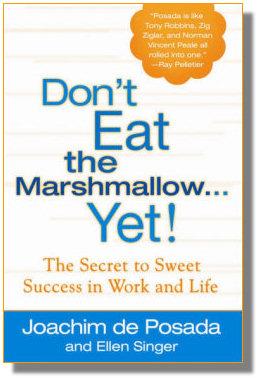
To Eat or not to Eat… the Marshmallow?
Joachim de Posada’s 2005 work “Don’t Eat the Marshmallow… Yet!” is, in this economic depression, extremely relevant and gives useful advice on how to save money and prosper.
This book in essence shows the difference between instant and delayed gratification. It is based on a study that Walter Mischel of Stanford University began in 1972. Children were given a marshmallow and told that if they waited for 15 minutes without eating the marshmallow, they could have another one. If they ate it, they did not get an extra marshmallow. In short, the study was held to compare children with self-discipline and those without it. In the later follow-up studies, Mischel found out that the children who had waited the time out and earned another marshmallow had grown up to be more competent than their peers who had not waited and chosen to eat their marshmallows. Additionally those who had waited earned higher SAT scores than those who had not waited.
The story develops differently from many other self-help books that throw all the tips at you from the start. Instead, the story revolves around Arthur, who is a chauffeur for Jonathan, his employer. Jonathan and Arthur are both very talented and are highly intelligent, with their difference being that Jonathan is a billionaire and Arthur is not. Arthur is a symbol of the common man, while Jonathan, who had participated in the marshmallow experiment, is Posada’s persona and the vehicle for the advice he has to give. Every chapter, Jonathan gives Arthur a new piece of advice, which Arthur sets about implementing in his life.
After applying Jonathan, or Posada’s advice, into his life, Arthur finds that money seemingly comes out of nowhere and begins to pile up. Thus, while the plot of Posada’s work drives along the message and advice coming from the book, it additionally serves as an example of what could happen if one follows the rules set forth by it.
Through the persona of Jonathan who teaches Arthur the value of delaying gratification, Posada uses his story as a didactic tale to impart his advice. The book is very different from many other self-help books in that its tone is rather light and flowing, unlike the cut and dry guides that dully throw all their tips out at once.

